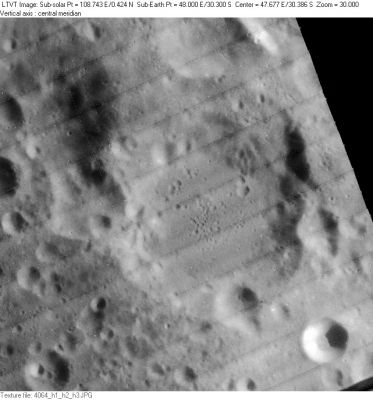Reichenbach
Contents
Reichenbach
|
Lat: 30.3°S, Long: 48.0°E, Diam: 71 km, Depth: 3.2 km, Rükl: 69 |
LO-IV-064 The dark area in the upper left is part of irregular 64-km Reichenbach T. The 15-km crater with the neatly tapering walls is Reichenbach G. Several other lettered craters named after Reichenbach are also wholly or partially visible in this frame.
Images
LPOD Photo Gallery Lunar Orbiter Images Apollo Images
Maps
(LAC zone 97C3) LAC map Geologic map
Description
Description: Elger
(IAU Directions) REICHENBACH.--A very abnormally-shaped ring-plain, about 30 miles in diameter, with a rampart nearly 12,000 feet high. The border is broken on the E., S., and W. by craters and depressions, and on the N. is flanked by two overlapping ring-plains, a and b. On the S.E. lies a magnificent serpentine valley, fully 100 miles in length and about 12 miles in breadth at the N. end, but gradually diminishing as it runs southwards, till it reaches a depression N. of Rheita, where it terminates: here is scarcely more than 4 miles wide.
Description: Wikipedia
Additional Information
Depth data from Kurt Fisher database
- Pike, 1976: 3.2 km
- Westfall, 2000: 3.2 km
- Viscardy, 1985: 4 km
- Cherrington, 1969: 3.41 km
- Central peak height
- Sekiguchi, 1972: 0.4 km - fatastronomer
- Reichenbach A central peak height
- Sekiguchi, 1972: 0.9 km - fatastronomer
- Reichenbach B central peak height
- Sekiguchi, 1972: 0.7 km - fatastronomer
- Reichenbach C central peak height
- Sekiguchi, 1972: 0.3 km - fatastronomer
- Reichenbach D central peak height
- Sekiguchi, 1972: 1.6 - fatastronomer
- Reichenbach T central peak height
- Sekiguchi, 1972: 1.5 km, a lower peak on the north part of the floor is 1.0 km tall - fatastronomer
- Reichenbach Z central peak height
- Sekiguchi, 1972: 0.8 km - fatastronomer
- Satellite craters Reichenbach A, C, K and P are on the ALPO list of banded craters
Nomenclature
Georg von Reichenbach (August 24, 1771 - May 21, 1826) was a German astronomical instrument maker. Reichenbach's principal merit was that he introduced into observatories the meridian or transit circle, combining the transit instrument and the mural circle into one instrument.
Reichenbach A was called Steavenson by Wilkins and Moore, but the IAU did not accept that name.
- W H Steavenson (Wikipedia) was a celebrated contemporary English amateur astronomer.
A crater-chain to the southeast of Reichenbach is called the Reichenbach Valley, see page 41 in Patrick Moore's The Guinness Book of Astronomy, Facts and Feats (1983). This could be the oblong formation Rheita E (south-southeast of Reichenbach, between Reichenbach, Rheita, and Stevinus).
LPOD Articles
Bibliography
A Portfolio of Lunar Drawings (Harold Hill), page 238 (the Neander-Reichenbach-Rheita region at sunset).
Reichenbach A (Steavenson): Wilkins and Moore.
W. H. Steavenson (the IAU's Reichenbach A) in the Sourcebook Project (William R. Corliss)
- In: Mysterious Universe, a handbook of astronomical anomalies (1979) :
- Transit of a Dark Body across the Moon's Disc (Journal of the British Astronomical Association, 1920)
- Bright Objects observed near the Sun (Journal of the British Astronomical Association, 1914)
